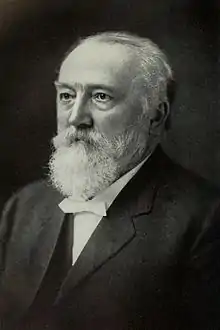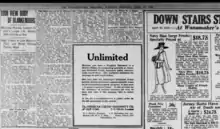Rudolph Blankenburg
Rudolph Blankenburg (February 16, 1843 – April 12, 1918) was an American businessman and manufacturer, who became a politician and elected mayor of Philadelphia, leading a reform administration from 1911 to 1916.[1]
Rudolph Blankenburg | |
|---|---|
 | |
| 81st Mayor of Philadelphia, Pennsylvania | |
| In office December 4, 1911 – January 3, 1916 | |
| Preceded by | John E. Reyburn |
| Succeeded by | Thomas B. Smith |
| Personal details | |
| Born | February 16, 1843 Barntrup, Principality of Lippe |
| Died | April 12, 1918 (aged 75) Germantown, Pennsylvania |
| Political party | Keystone-Democratic |
| Spouse | |
| Occupation | Manufacturer |
| Signature | |
Biography
Blankenburg was born in Barntrup,[2] Principality of Lippe. From age 7 to 14, he was tutored by Carl Becker, a graduate of the Free University of Berlin.[3] He showed an aptitude for languages, and became proficient in English and French, in addition to German.[3] At the age of fourteen he left home to spend three years studying at the Real Gymnasium at Lippstadt.[3]
In 1865, Blankenburg followed Becker to America. He began working as a salesman and then became a textile manufacturer. He also began associating with the Society of Friends. He became wealthy and retired from his business concerns in 1909.[4][5]
Blankenburg became a naturalized U.S. citizen.[3]
On April 18, 1867, Blankenburg married Lucretia Longshore (May 8, 1845 – March 29, 1937),[6] a Quaker suffragist, social activist, civic reformer, and writer.[7] Longshore was the daughter of pioneering physician Hannah E. Longshore, who died on October 19, 1901, at the Blankenburgs' home at 214 Logan Square.[8] The street on which that address was located, West Logan Square, ceased to exist when Logan Square was extended westward in the creation of the Benjamin Franklin Parkway.
He began taking an interest in civic improvement and reform politics in Philadelphia in 1877. He was elected county commissioner for Philadelphia in 1905, serving 1906–1909. He was then elected mayor of Philadelphia in 1911 on the Keystone-Democratic ticket; the coalition was organized to fight Republican corruption in the state and city. He served as mayor from December 1911 to January 1916.[4][6][9]
Because of his commitment to progressive reform, he was known as "The Old War Horse of Reform" and "The Old Dutch Cleanser" [10](a play on a cleaning product brand). He ended assessments by ward leaders of policemen, reorganized the civil service system to have it based on merit, gained passage by the legislature of a bill to enable the city to lease development of subway and transit lines, and worked for reform for 40 years as a political activist.[11]
In earlier years he was a worldwide traveler. He also became known by his numerous magazine and newspaper articles on social, economic and religious questions.[4]
Blankenburg died in the Germantown section of Philadelphia. In accordance with his wishes, his body was cremated and his ashes buried at Fair Hill Burial Ground alongside the bodies of his three children.[12]
Legacy

More than 6,000 people viewed Blankenburg's body and attended his funeral, held at the Arch Street Methodist Church.
In 1921 the City of Philadelphia contracted with the John W. Sullivan Company of New York for the construction of a 129-foot, steam-powered, all-steel fireboat to be named the Rudolph Blankenburg.[13] The boat was launched in Elizabeth, New Jersey on August 10 of that year, sponsored by Blankenburg's widow, Lucretia, who broke a bottle of Champagne across its bow.[14] The fireboat remained in service until 1950.[15] That year, the Blankenburg and its running mate, the J. Hampton Moore (which was named after another mayor of Philadelphia), were replaced by a pair of diesel-powered fireboats, the Franklin and the Delaware.[16]
The Rudolph Blankenburg Elementary School in Philadelphia was built in the 1920s.
References
- "Rudolph Blankenburg Assumes Control of Mayor's Office". The Philadelphia Inquirer. December 5, 1911. p. 1. Retrieved June 14, 2023 – via Newspapers.com.
- Place of birth
- Blankenburg, Lucretia (1929). The Blankenburgs of Philadelphia, by one of them, Lucretia L. Blankenburg. The John C. Winston Company. pp. 1–2. Retrieved June 14, 2023 – via Internet Archive.
- This article incorporates text from a publication now in the public domain: Rines, George Edwin, ed. (1920). . Encyclopedia Americana.
- Clinton Rogers Woodruff (1936). "Blankenburg, Rudolph". Dictionary of American Biography. New York: Charles Scribner's Sons.
- Yearbook of the Pennsylvania Society of New York 1919. 1919. p. 172.
- Olive Hoogenboom (1999). "Blankenburg, Lucretia Longshore". American National Biography (online ed.). New York: Oxford University Press. doi:10.1093/anb/9780198606697.article.1500880. (subscription required)
- "Dr. Hannah E. Longshore". Friends' Intelligencer. 58 (43): 686.
- A "fusion between the Democratic party and the Keystone party, which had been organized [in 1909] to combat alleged political corruption in State and city..." [The Story of Philadelphia. Joyce, J. St. George, ed. Harry B. Joseph:1919; p. 300.]
- "Rudolph Blankenburg" (PDF). Historical Society of Pennsylvania. Retrieved January 12, 2022.
- "R. Blankenburg Dies; The Reform Mayor". The New York Times. Philadelphia, Pennsylvania (published April 13, 1918). April 12, 1918. p. 13. Retrieved June 14, 2023 – via Newspapers.com.
- "6000 View Body of Blankenburg / Men and Women, Leaders in City's Larger Life, Mingle With Humble at Bier / High Tribute to Late Mayor's Civic and Moral Virtues Paid by Many". The Philadelphia Inquirer. April 16, 1918. p. 4. Retrieved June 14, 2023 – via Wikimedia Commons.
- "New Fireboat for City / 'Rudolph Blankenburg' May Be On Rivers Before End of Year". The Philadelphia Inquirer. February 24, 1921. p. 2. Retrieved June 14, 2023 – via Newspapers.com.
- "Champagne Crashed as Boat Is Launched". Plainfield Courier-News. Elizabeth. August 10, 1921. p. 1. Retrieved June 14, 2023 – via Newspapers.com.
- "5-Alarm Blaze Perils Gas Tanks". The Philadelphia Inquirer. February 22, 1950. p. 27. Retrieved June 14, 2023 – via Newspapers.com.
- "City to Receive Fireboat Today". The Philadelphia Inquirer. May 15, 1950. p. 17. Retrieved June 14, 2023 – via Newspapers.com.
Further reading
- George E. Mapes (May 26, 1906). "An Uncompromising Fighter". The Outlook. LXXXIII: 220–223.
- Lucretia Longshore Blankenburg, The Blankenburgs of Philadelphia, 1928
